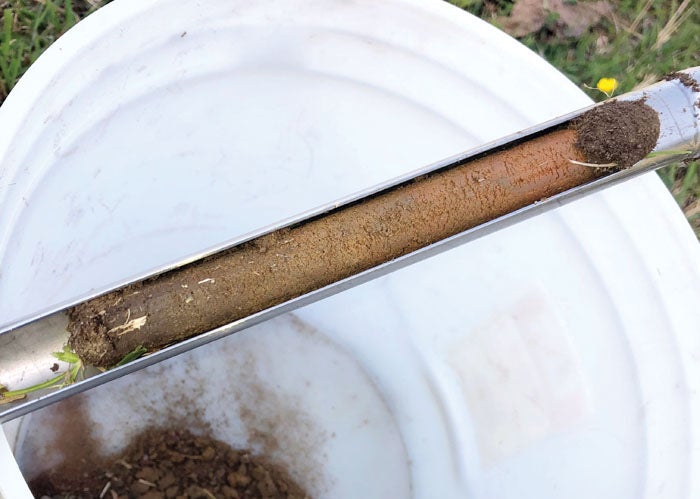Cody Craddock column: How to interpret soil tests
Published 12:00 am Saturday, December 25, 2021

- Taking a soil sample for a soil test.
By Cody Craddock
N.C. Cooperative Extension
Many Rowan County residents visited our office for soil sample boxes, paperwork and advice this summer and fall. Soil testing is a free service for all North Carolina residents from April through November every year. From December through March, the lab charges a small fee per sample since this is their peak testing time. We always advise people to avoid the fee if possible.
Since many folks received testing supplies from our office and submitted samples, surely there’s lots of soil reports made out to residents of Rowan County. However, the soil report can be a bit confusing, so grab your soil report and keep reading because this article will help you decipher those results.
The first thing you should look at on your report is the far-left box where your “Sample ID” and “Crop 1” is found. Whether it be a flower garden or vegetable garden, the code you used on the original form told the lab what plants you grow or plan to grow, so your results are tailored to that crop. For example, blueberries love acidic soils with low pH. If you are growing blueberries, it is very unlikely the soil report advises you to add any lime since lime will raise the pH. The fertilizer recommendations for that site will also be customized to the crop you put in the code box. Keep that in mind.
To the right, you’ll see a bar graph with pH test results ranging from acidic to alkali pH. The number on the left is your soil’s pH, and the shaded-out portion is the visual representation of that number. There will also be an “optimum pH range” which is where the lab recommends you amend the soil to be within. Further to the right will be a lime recommendation which is based on the crop 1 listed on your report. Apply lime at this rate if the soil pH is low, to raise it to the optimum range. Applying additional lime if this value is at “0.0” is not recommended since high soil pH can cause problems. If the soil pH is too high, you may need to apply a soil acidifier to help bring it down to the optimum range. Common acidifiers use elemental sulfur, aluminum sulfate, or even sulfuric acid to lower soil pH. It’s fairly uncommon for a home garden to need this treatment unless you are planting acid-loving plants like blueberries, hydrangeas and azaleas. Keep in mind both lime and acidifiers can take up to one year to raise and lower the pH of the soil so give them time to take effect.
On the far-right, you will see another two bar graphs which are your Phosphorous and Potassium indices. To the left of these graphs, you’ll find the number representation (P-I and K-I). These indices tell you how much nutrients are available to the plants based on their levels in the soil. The “optimum range” for these nutrients is 50-70. Anything lower than those numbers will require adjustment with fertilizer. Anything above those numbers is considered high and not in need of adjustment. Adding phosphorus and potassium if your report is in the optimum range or above is only adding nutrients that plants don’t need that will eventually leach or runoff out of the soil. Above these graphs you will find your “N-P-K Fertilizer Recommendations” which is based on the soil nutrient indices and the crop you’re growing. Apply this fertilizer at the recommended rate for the best results.
The last section of the soil report falls under the pH graph on the left side and is your “additional test results” containing information about soil properties and micronutrients. HM% is your soil’s humic matter content which is a measure of the organic matter in the soil. W/V is the weight to volume ratio and is expressed in g/cm3. Lastly, there is CEC which stands for cation exchange capacity. This measurement is an expression of how well the soil can hold onto nutrients. Sandier soils will usually be lower since nutrients leach through easier. Soils with a CEC above 10-12 are usually considered to have moderate holding capacity for nutrients. Anything lower is prone to leaching, and anything above holds nutrients well. The three of these (HM%, W/V, and CEC) are all physical properties of the soil.
The last four numbers in the “additional test results” category are all indices like the ones for phosphorus and potassium. These indices measure manganese, zinc, copper and sulfur availability. For all of these nutrients, anything above 25 is considered sufficient but may be needed in small amounts rarely.
Soil is such a complex and important part of growing plants. The pH level can cause nutrient mobility issues; poor nutrient levels can cause deficiencies, and adding too much fertilizer can contribute to soluble salt buildup. Healthy soils are those that people manage to create the ideal growing conditions for plants. It’s much easier said than done, but we are here to help! If you have any questions regarding soils or soil sampling, reach out to us at N.C. Cooperative Extension.
Cody Craddock is an ag/natural resources agent with the Rowan County Extension.




